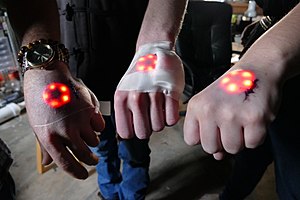This article is an autobiography or has been extensively edited by the subject or by someone connected to the subject.(April 2017) |
 Photos of Grindhouse Wetware's Northstar Device | |
| Industry | Biotechnology, Synthetic Biology |
|---|---|
| Founded | 2011 |
| Founders | Tim Cannon, Shawn Sarver |
| Headquarters | , U.S |
Key people | Ryan O'Shea (Spokesman) |
| Website | www |
Grindhouse Wetware is an open source biotechnology startup company based in Pittsburgh, Pennsylvania. Grindhouse applies the biohacker ethic to create technology that augments human capabilities. The company is most well known for their Circadia device, a wireless biometric sensor that was implanted into co-founder Tim Cannon on the 22 October 2013. [1] Grindhouse has been featured in television shows such as Taboo on National Geographic Channel, [2] Joe Rogan Questions Everything on Syfy, [3] The Big Picture with Kal Penn , [4] [5] as well as podcasts including Future Grind [6] and Roderick Russell's Remarkably Human. [7]
In November 2015, Grindhouse members Tim Cannon, Shawn Sarver, Justin Worst, Jessica Waldrip, Michael Seeler, and Marlo Webber had prototypes of Grindhouse's Northstar device implanted into their hands during simultaneous procedures occurring at the "Cyborg Fair" in Düsseldorf, Germany, and at a studio in Pittsburgh. The implantation procedure was featured in an episode of the MTV documentary series True Life . Also featured in the episode was the public debut of the morse code functionality of Grindhouse's Bottlenose device at the first Pittsburgh Maker Faire. [8]